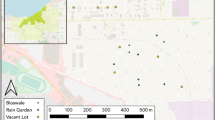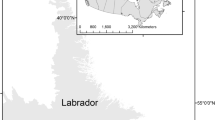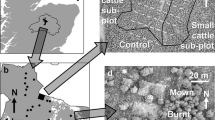Abstract
We combined a natural experiment with field surveys and GIS to investigate the effects of dust from recreational trails and access roads on the federally threatened Valley elderberry longhorn beetle (“VELB,” Desmocerus californicus dimorphus) and its host plant, elderberry (Sambucus mexicana). Dust is listed in the species recovery plan as a threat to the VELB and unpaved surfaces are common throughout the riparian corridors where the VELB lives, yet the effects of dust on the VELB have been untested. We found that dust deposition varied among sites and was highest within 10 m of trails and roads, but was similar adjacent to dirt and paved surfaces within sites. Elderberry density did not differ with distance from dirt surfaces. Despite similar within-site dust levels, elderberry adjacent to paved surfaces were less stressed than those near dirt ones, possibly because increased runoff from paved surfaces benefited elderberry. Dust deposition across sites was weakly correlated with elderberry stress symptoms (e.g., water stress, dead stems, smaller leaves), indicating that ambient dust (or unmeasured correlates) influenced elderberry. Direct studies of the VELB showed that its distribution was not negatively affected by the proximity to dirt surfaces. Dust from low traffic dirt and paved access roads and trails, therefore, affected VELB presence neither directly nor indirectly through changed elderberry condition. These results suggest that the placement of VELB mitigation, restoration, and conservation areas can proceed independently of access roads if dust and traffic levels do not exceed those in our study site. Furthermore, dust control measures are likely to be unnecessary under such conditions. The potential effects of increased traffic and dust levels are addressed through a literature review.




Similar content being viewed by others
Literature Cited
Arnold, R. 1984. The endangered valley elderberry longhorn beetle in the north Sacramento area. Unpublished report to Ms. Carolyn Slobe, North Sacramento Land Company. 10 pp
Becker D. L., E. S. Takle. 1979. Particulate deposition from dry unpaved roadways. Atmospheric Environment 13:661–668
Braun S., W. Flückiger. 1987. Does exhaust from motorway tunnels affect the surrounding vegetation. In P. Mathy and D. Reidel (eds.) Air pollution and ecosystems. Reidel Publishing Company, Dordrecht, Holland. pp 665–670
Cohen J. 1992. A power primer. Psychological Bulletin 112:155–159
Czaja A. T. 1961. Die wirkung von verstaubtem kalk und zement auf pflanzen. Qualitas Plantarum et Materiae Vegetabiles 8:184–212
Czaja A. T. 1962. Uber das problem der zementstaubwirkung auf pflanzen. Staub 22:228–232
Eller B. M. 1977. Road dust induced increase of leaf temperature. Environmental Pollution 13:99–107
Erdfelder E., F. Faul, and A. Buchner. 1996. GPOWER: A general power analysis program. Behavior Research Methods, Instruments, and Computers 28:1–11. Program available at http://www.psycho.uni-duesseldorf.de/aap/projects/gpower/
Eveling D. W. 1969. Effects of spraying plants with suspensions of inert dusts. Annals of Applied Biology 64:139–151
Everett K. R. 1980. Distribution and properties of road dust along the northern portion of the haul road. In J. Brown and R. Berg (eds.) Environmental engineering and ecological baseline investigations along the Yukon River-Purdhoe Bay Haul Road (CRREL Report 80–19). US Army Cold Regions Research and Engineering Laboratory. Hanover, New Hampshire. pp 101–128
Farmer A. M. 1993. The effects of dust on vegetation: A review. Environmental Pollution 79:63–75
Federal Register. 1980. Listing the Valley Elderberry Longhorn Beetle as a threatened species with critical habitat. V. 45, No. 155, Friday, August 8, 1980. Office of the Federal Register, National Archives and Records Administration. http://www.sacramento.fws.gov/es/animal_spp_acct/valley_ elderberry_longhorn_beetl.htm
Gale J., J. Easton. 1979. The effect of limestone dust on vegetation in an area with a Mediterranean climate. Environmental Pollution 19:89–101
Gomez B., M. Gomez J. L. Sanchez R. Fernandez M. A. Palacios. 2001. Platinum and rhodium distribution in airborne particulate matter and road dust. Science of the Total Environment 269:131–144
Haack R. A., F. Slansky Jr. 1987. Nutritional ecology of wood-feeding Coleoptera, Lepidoptera and Hymenoptera. In F. Slansky Jr., and J. G. Rodriguez (eds.) Nutritional ecology of insects, spiders, mites and related invertebrates, J. Wiley, New York. pp 449–486
Hanks L. M. 1999. Influence of the larval host plant on reproductive strategies of Cerambycid beetles. Annual Review of Entomology 44:483–505
Hirano T., M. Kiyota, I. Aiga. 1995. Physical effects of dust on leaf physiology of cucumber and kidney bean plants. Environmental Pollution 89:255–261
Linsley E. G., J. A. Chemsak. 1972. Cerambycidae of North America. Part VI, No. 1. Taxonomy and classification of the subfamily Lepturinae. University of California Publications in Entomology 69:1–138
Morrison M. L., K. S. Smallwood L. S. Hall. 2003. Creating habitat through plant relocation: Lessons from Valley Elderberry Longhorn Beetle Mitigation. Ecological Restoration 21:95–100
Naqvi R. R., M. I. Khattak. 1996. Lead and cadmium levels in soil and plants near roadsides around Karachi correlated with traffic density. Sarhad Journal of Agriculture 12:575–585
Pagotto C., N. Remy, M. Legret, P. Le Cloirec. 2001. Heavy metal pollution of road dust and roadside soil near a major rural highway. Environmental Technology 22:307–319
Roberts J. W., H. A. Watters, C. A. Mangold, A. T. Rossano. 1975. Cost and benefits of road dust control in Seattle’s industrial valley. Journal of Air Pollution Control Association 25:948–952
Sharifi M. R., A. C. Gibson, P. W. Rundel. 1997. Surface dust impacts on gas exchange in Mojave Desert shrubs. Journal of Applied Ecology 34:837–846
Smith J. 1996. The Outdoor World of the Sacramento Region. American River Natural History Association, Sacramento, California, USA. 214pp
Sokal R. R., and F. J. Rohlf. 1995. Biometry. W. H. Freeman and Co., New York
Thompson J. R., P. W. Mueller, W. Flückiger A. J. Rutter. 1984. The effect of dust on photosynthesis and its significance for roadside plants. Environmental Pollution (Series A) 34:171–190
Trombulak S. C, C. A. Frissell. 2000. Review of ecological effects of roads on terrestrial and aquatic communities. Conservation Biology 14:18–30
U. S. Fish, Wildlife Service (USFWS). 1984. Valley Elderberry Longhorn Beetle Recovery Plan. U.S. Fish and Wildlife Service, Portland, OR. 62 pp
Walker D. A., K. R. Everett. 1987. Road dust and its environmental impact on Alaskan taiga and tundra. Arctic and Alpine Research 19:479–489
Acknowledgments
We thank Tasila Banda, Angela Calderaro, Soledad Sanchez, and Sara Wood for their enthusiastic help with the field and laboratory studies. We are indebted to Bobby Jo Close and the California Conservation Corps for help with the extensive American River Parkway mapping effort. We thank Sacramento County Parks for GIS data and permission to conduct this study along the American River Parkway, the American River Flood Control District for access to levee roads, and the US Fish and Wildlife Service for support of our work on this threatened species (Permit number TE043408−0). Dave Lydick and Bill Katen (Sacramento County Parks) provided data on traffic levels along the Parkway, and Richard Marck (ARFCD) provided data as well as much appreciated on-the-ground support. We appreciate the scientific writing talents of Laura Svensgaard, and the use of field equipment generously provided by Kevin Rice and Sharon Strauss (UC-Davis). Funding for this project came from the National Fish and Wildlife Foundation, Sacramento Area Flood Control Agency, Sacramento County Parks, Sacramento County Dept. of Environmental Review and Assessment, American River Flood Control District, Pacific Gas and Electric, Sacramento Municipal Utility District, Sacramento Regional County Sanitation District, Western Area Power Authority, California Dept. of Water Resources and Reclamation Board, Federal Highways Administration, and the City of Sacramento. We are especially grateful to Peter Buck and Tim Washburn (SAFCA) for their insightful participation in this work and the orchestration of this productive multiagency collaboration. Trevor Burwell, Greg Golet, and three anonymous reviewers provided helpful reviews of this manuscript.
Author information
Authors and Affiliations
Corresponding author
Rights and permissions
About this article
Cite this article
Talley, T.S., Holyoak, M. & Piechnik, D.A. The Effects of Dust on the Federally Threatened Valley Elderberry Longhorn Beetle. Environmental Management 37, 647–658 (2006). https://doi.org/10.1007/s00267-004-0320-6
Published:
Issue Date:
DOI: https://doi.org/10.1007/s00267-004-0320-6




